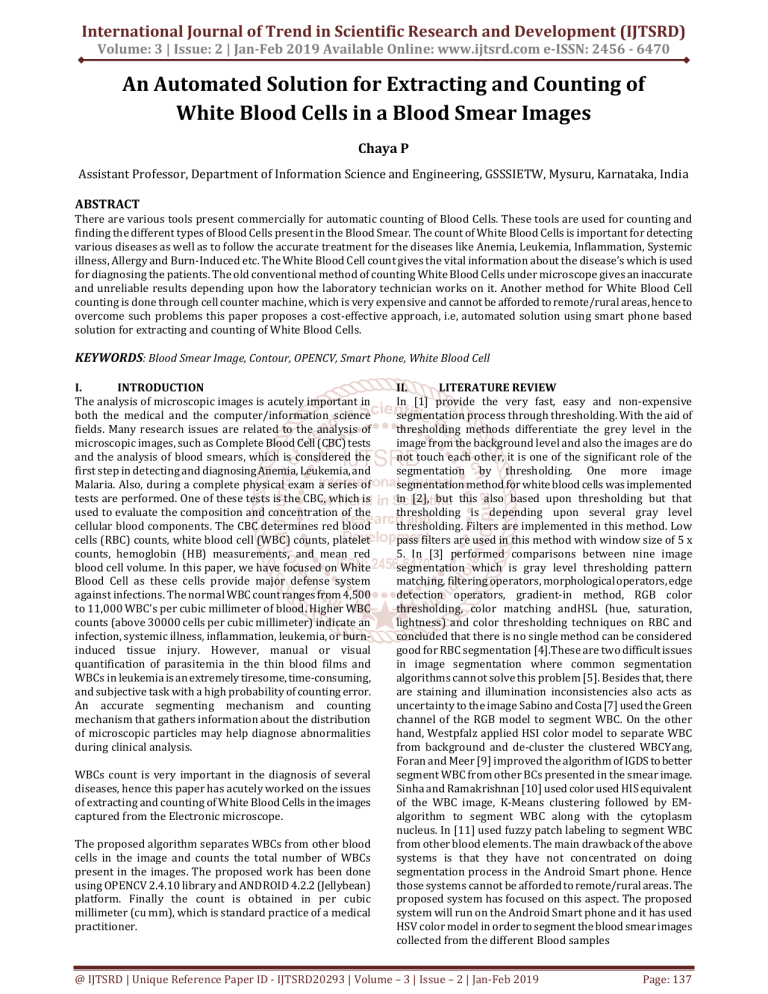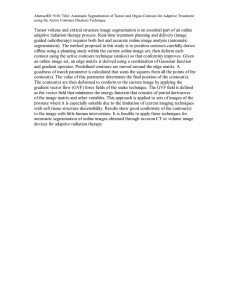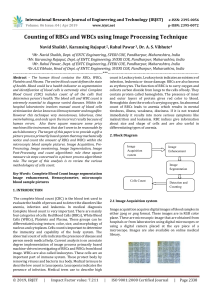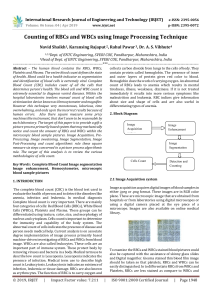
International Journal of Trend in Scientific Research and Development (IJTSRD)
Volume: 3 | Issue: 2 | Jan-Feb 2019 Available Online: www.ijtsrd.com e-ISSN: 2456 - 6470
An Automated Solution for Extracting and Counting of
White Blood Cells in a Blood Smear Images
Chaya P
Assistant Professor, Department of Information Science and Engineering, GSSSIETW, Mysuru, Karnataka, India
ABSTRACT
There are various tools present commercially for automatic counting of Blood Cells. These tools are used for counting and
finding the different types of Blood Cells present in the Blood Smear. The count of White Blood Cells is important for detecting
various diseases as well as to follow the accurate treatment for the diseases like Anemia, Leukemia, Inflammation, Systemic
illness, Allergy and Burn-Induced etc. The White Blood Cell count gives the vital information about the disease’s which is used
for diagnosing the patients. The old conventional method of counting White Blood Cells under microscope gives an inaccurate
and unreliable results depending upon how the laboratory technician works on it. Another method for White Blood Cell
counting is done through cell counter machine, which is very expensive and cannot be afforded to remote/rural areas, hence to
overcome such problems this paper proposes a cost-effective approach, i.e, automated solution using smart phone based
solution for extracting and counting of White Blood Cells.
KEYWORDS: Blood Smear Image, Contour, OPENCV, Smart Phone, White Blood Cell
I.
INTRODUCTION
The analysis of microscopic images is acutely important in
both the medical and the computer/information science
fields. Many research issues are related to the analysis of
microscopic images, such as Complete Blood Cell (CBC) tests
and the analysis of blood smears, which is considered the
first step in detecting and diagnosing Anemia, Leukemia, and
Malaria. Also, during a complete physical exam a series of
tests are performed. One of these tests is the CBC, which is
used to evaluate the composition and concentration of the
cellular blood components. The CBC determines red blood
cells (RBC) counts, white blood cell (WBC) counts, platelet
counts, hemoglobin (HB) measurements, and mean red
blood cell volume. In this paper, we have focused on White
Blood Cell as these cells provide major defense system
against infections. The normal WBC count ranges from 4,500
to 11,000 WBC’s per cubic millimeter of blood. Higher WBC
counts (above 30000 cells per cubic millimeter) indicate an
infection, systemic illness, inflammation, leukemia, or burninduced tissue injury. However, manual or visual
quantification of parasitemia in the thin blood films and
WBCs in leukemia is an extremely tiresome, time-consuming,
and subjective task with a high probability of counting error.
An accurate segmenting mechanism and counting
mechanism that gathers information about the distribution
of microscopic particles may help diagnose abnormalities
during clinical analysis.
WBCs count is very important in the diagnosis of several
diseases, hence this paper has acutely worked on the issues
of extracting and counting of White Blood Cells in the images
captured from the Electronic microscope.
The proposed algorithm separates WBCs from other blood
cells in the image and counts the total number of WBCs
present in the images. The proposed work has been done
using OPENCV 2.4.10 library and ANDROID 4.2.2 (Jellybean)
platform. Finally the count is obtained in per cubic
millimeter (cu mm), which is standard practice of a medical
practitioner.
LITERATURE REVIEW
II.
In [1] provide the very fast, easy and non-expensive
segmentation process through thresholding. With the aid of
thresholding methods differentiate the grey level in the
image from the background level and also the images are do
not touch each other, it is one of the significant role of the
segmentation by thresholding. One more image
segmentation method for white blood cells was implemented
in [2], but this also based upon thresholding but that
thresholding is depending upon several gray level
thresholding. Filters are implemented in this method. Low
pass filters are used in this method with window size of 5 x
5. In [3] performed comparisons between nine image
segmentation which is gray level thresholding pattern
matching, filtering operators, morphological operators, edge
detection operators, gradient-in method, RGB color
thresholding, color matching andHSL (hue, saturation,
lightness) and color thresholding techniques on RBC and
concluded that there is no single method can be considered
good for RBC segmentation [4].These are two difficult issues
in image segmentation where common segmentation
algorithms cannot solve this problem [5]. Besides that, there
are staining and illumination inconsistencies also acts as
uncertainty to the image Sabino and Costa [7] used the Green
channel of the RGB model to segment WBC. On the other
hand, Westpfalz applied HSI color model to separate WBC
from background and de-cluster the clustered WBCYang,
Foran and Meer [9] improved the algorithm of IGDS to better
segment WBC from other BCs presented in the smear image.
Sinha and Ramakrishnan [10] used color used HIS equivalent
of the WBC image, K-Means clustering followed by EMalgorithm to segment WBC along with the cytoplasm
nucleus. In [11] used fuzzy patch labeling to segment WBC
from other blood elements. The main drawback of the above
systems is that they have not concentrated on doing
segmentation process in the Android Smart phone. Hence
those systems cannot be afforded to remote/rural areas. The
proposed system has focused on this aspect. The proposed
system will run on the Android Smart phone and it has used
HSV color model in order to segment the blood smear images
collected from the different Blood samples
@ IJTSRD | Unique Reference Paper ID - IJTSRD20293 | Volume – 3 | Issue – 2 | Jan-Feb 2019
Page: 137
International Journal of Trend in Scientific Research and Development (IJTSRD) @ www.ijtsrd.com eISSN: 2456-6470
III.
METHODOLOGY
This paper introduces an automatic WBC count using
computer vision which helps to perform the counts
accurately using image based analysis from which the blood
smear taken by the electronic microscopic. Steps involved in
the process of estimating the White Blood Cells include:
Image Acquisition, Image Preprocessing, Image
Segmentation, Image Post processing and WBC counting.
Figure 1 shows the overall flow of the proposed system.
Figure.3, shows the original blood smear microscopic image
Figure.3: Original blood smear microscopic image
B. Image Pre-Processing
The input for this step is a blood smear image and this image
is enhanced and filtered to get a good quality image for the
next steps. The higher resolution image is decoded using
Bitmap decode in order to reduce the resolution of the
image.
Figure.1: Flowchart of the proposed system
Further the image is converted to HSV image, which clearly
defines the bright objects such as WBC. The pre-processed
image is sent for Image Segmentation. Figure. 4, shows the
HSV image.
A. Image Acquisition
This is the first method which is performed to capture the
image from the prepared blood smear image using
Electronic microscope. The blood smear slide is prepared in
the form of tongue shape, and then the images are captured
from the feather edge of the blood smear as shown in
Figure2. The images are captured from the slides by an
Olympus BX50 microscope equipped with Moti camera.
For the proposed method the blood smear images of the two
patients are considered, for each patient a single slide is
prepared from which ten sample images are captured at
different angles. These images are stored in JPEG format. The
dataset used in this project consists of actual microscopic
images of blood samples, captured in the Laboratories.
Figure.4: HSV image.
Figure 2: Blood smear in tongue shape
The images were taken by placing the prepared blood smear
under the electronic microscope at a magnification factor of
40x. The image thus captured is provided as an input for the
preprocessing stage.
C. Image Segmentation
The input for this step is the pre-processed image. Here two
threshold values have been considered namely lower and
upper threshold values. Where the lower threshold value is
set to (120,100,100) and the upper threshold value is set to
@ IJTSRD | Unique Reference Paper ID - IJTSRD20293 | Volume – 3 | Issue – 2 | Jan-Feb 2019
Page: 138
International Journal of Trend in Scientific Research and Development (IJTSRD) @ www.ijtsrd.com eISSN: 2456-6470
(179,255,255), in order to segment the image. i.e, these
threshold values are applied to extract the saturation
component say S, because this S in the image show clearly
the White blood cells. Figure 5, shows the segmented image.
Figure.7: Extraction of contours
Figure.5: Segmented image
D. Image Post-Processing
After segmentation the noise present in the segmented
image will be removed using Gaussian blur method of kernel
size 17 x 17. A Contour can be explained simply as a curve
joining continuous points, having same color or intensity.
The proposed method extracts the contours of the cells in
the segmented image and then the area of the each contour
will be found. From the experimental results we found that if
the contour area lies between 5,400 to 6,000 pixels, then
those contours are considered as WBCs contours. For
highlighting WBCs area draw contour method is used. In this
case, we obtain three different images for each method.
Figure 6, shows the image after applying Guassian blur.
Figure 7, shows the image after extracting the contours.
Figure 8, shows the image after applying Draw contour.
Figure.8: After applying draw contour
Figure.6: After applying Guassian Blur
E. Counting
After the application of Draw contour method only the WBCs
cells will be highlighted, which will be used for counting
purposes. However, blood count in medical terms means the
number of blood cells in a cubic millimeter of blood volume.
Hence we have deduced a formula (1) to calculate the
number of white blood cells per cubic millimeter, based on
the number of cells in the area of the given image of the
blood sample. We have assumed that the thickness of the
blood sample film is 0.1 mm, which is the normal medical
practice. This allows for an overlapping of maximum two
layers in thickness, which is the common trend in the images
provided. This formula requires number of white blood cells
@ IJTSRD | Unique Reference Paper ID - IJTSRD20293 | Volume – 3 | Issue – 2 | Jan-Feb 2019
Page: 139
International Journal of Trend in Scientific Research and Development (IJTSRD) @ www.ijtsrd.com eISSN: 2456-6470
obtained from each blood smear image, where the number of
blood smear images per patient is considered to be ten.
There is a standard value which is suggested by the
pathology technician, which is a constant value to be
multiplied with the result obtained from dividing the
number of White blood cells obtained with the number of
input images per patient i.e., ten. The overall result is
measured in cubic millimeter (cu mm). Considering these
factors the formula for the WBCs count becomes:
Segmentation Techniques”,
Proceeding
of
International Conference on Man-Machine Systems
2006, September 15-16 2006, Langkawi, Malaysia.
[4]
Nor HazlynaHarun , N. R. Mokhtar ,M. Y. Mashor, H.
Adilah, R. Adollah, Nazahah Mustafa, N. F. MohdNasir ,
H. Roseline, ‘Color image enhancement techniques
based on partial contrast and contrast stretching for
acute leukaemia images’, ICPE-2008.
[5]
FatemehZamani,
Reza
Safabakhhsh:
“An
Unsupervised GVF Snake Approach for White Blood
Cell Segmentation Based on Nucleus”,
Signal
Processing, The 8th International Conference on
Volume 2, 2006.
[6]
Montseny, P. Sobrevilla, S. Romani (2004): “A Fuzzy
Approach to White Blood Cells Segmentation in Color
Bone Marrow Images”, IEEE on 25-29 July, 2004,
Budapest, Hungry
[7]
Sabino, D. M. U, L. da F. Costa, E. G. Rizzatti and M. A.
Zago, “A texture approach to leukocyte recognition,”
Real-Time Imaging, Vol.10, pp. 205–216, Usenet post
to http://www.cse.iitd.ernet.in/~csa03027, February
2004.
[8]
Hengen, H , O. Gabel, A. Hajra, T. Paulus, M. Ross and S.
Spoor, “Development of a system for the analysis and
classification of blood and bone marrow cell images to
support
morphological
diagnosis
of
leukemia,”Kaiserslautern,Germany, February 2004.
[9]
Yang, L, P. Meer and D. J. Foran, “Unsupervised
Segmentation Based on Robust Estimation and
Color Active Contour Models,” IEEE, Usenet post to
http://www.caip.rutgers.edu/riul/research/papers/p
df/snake.pdf, January 2004.
(1)
Where,
N = the actual WBC count per Cu mm.
C = WBC count obtained from images.
IV.
RESULTS AND DISCUSSION
Here in this paper we have considered five patient’s blood
smear images for our study. Each of these images is preprocessed by the above mentioned techniques. Finally the
number of White blood cells was extracted and counted in
each of these images bases on the contours area. The results
of our study have been discussed in Table – 1.
Table1. Comparison of the results between the proposed
method and the Manual method
Number of
Blood count
Images
Blood count
Patient
by
proposed
Taken
Manually
ID
method
per
per
per Cu mm
Cu mm
(in millions)
patient
(in millions)
1
2
3
4
5
10
10
10
10
10
4990
5020
4870
4980
5180
4800
4780
4950
4875
5030
V.
CONCLUSION
This paper presents a methodology to achieve an automated
extraction and counting of White blood cells in microscopic
images using Contours. This technique is affordable to
remote/rural area, independent of specialist to generate
patient WBC report. Results indicate that the proposed
method for White Blood Cell counting in blood smear images
offers a remarkable accuracy of 96.6% by restricting the
input images to ten in number per patient. The proposed
method is also very cost-effective and can be easily
implemented in medical facilities anywhere with minimal
investment in infrastructure. It is also very time effective as
manual counting is a very tedious job and time consuming.
VI.
[1]
REFERENCES
Milan Sonka, VaclawHlavac and Roger Boyle, “Image
processing, Analysis and Machine Vision”, Chapman
and Hall, London, 1993.
[2]
Ferdinand van der Heijden, “Image Based
Measurement Systems, Object Recognition and
Parameter Estimation”, John Wiley&Sons, West
Sussex, England, 1995
[3]
Khoo Boon How, Alex See Kok Bin, Alex See Kok Bin,
Ng TeckSiong, Khoo Kong Soo: “Red Blood Cell
Segmentation Utilizing
Various
Image
[10] Sinha, N (neelam@ee.iisc.ernet.in) and A. G.
Ramakrishnan
(ramkiag@ee.iisc.ernet.in),
“Automation of Differential Blood Count,” Bio-Medical
Lab, Department of Electrical Engineering, Indian
Institute of Science, Bangalore, IEEE, 2003.
[11] Ongun,G,U.Halici,K. Leblebicioglu and V. Atalay,
“Feature Extraction and Classification of Blood Cells
for an Automated Differential Blood Count System,”
IEEE International Joint Conference on Neural
Networks, pp. 2461-2466, 2001.
[12] Vinutha H Reddy. “Automatic RBC and WBC
counting for telemedicine system”. Volume 2, Issue 1,
January 2014.
[13] Prof. Samir K. Bandyopadhyay, Sudipta Roy/
International Journal of Engineering Research and
Applications (IJERA) “Detection of Sharp Contour of
the element of the WBC and Segmentation of two
leading elements like Nucleus and Cytoplasm”.
[14] P.S.Hiremath,, Parashuram Bannigidad, Sai Geeta
“Automated Identification and Classification of White
Blood Cells (Leukocytes) in Digital Microscopic
Images”. IJCA Special Issue on “Recent Trends in
Image Processing and Pattern Recognition” RTIPPR,
2010.
[15] International Journal of Emerging Technology and
Advanced Engineering Website: www.ijetae.com
(ISSN 2250-2459, ISO 9001:2008 Certified Journal,
Volume 3, Issue 6, June 2013) “White Blood C
@ IJTSRD | Unique Reference Paper ID - IJTSRD20293 | Volume – 3 | Issue – 2 | Jan-Feb 2019
Page: 140



